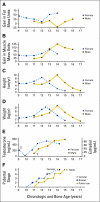Clinical pharmacology in the adolescent oncology patient
- PMID: 20439647
- PMCID: PMC3018345
- DOI: 10.1200/JCO.2010.28.3473
Clinical pharmacology in the adolescent oncology patient
Abstract
Numerous studies have documented that adolescents and young adults (AYAs) experience a significant cancer burden as well as significant cancer mortality compared with other age groups. The reasons for the disparate outcomes of AYAs and other age groups are not completely understood and are likely to be multifactorial, including a range of sociodemographic issues unique to these individuals as well as differences between adolescents, younger pediatric patients, and adults in the pharmacology of anticancer agents. Because adolescence is a period of transition from childhood to early adulthood, numerous physical, physiologic, cognitive, and behavioral changes occur during this time. In this review, we provide an overview of the unique developmental physiology of the adolescent and explain how these factors and the behavioral characteristics of adolescents may affect the pharmacology of anticancer agents in this patient population. Finally, we describe examples of studies that have assessed the relation between drug disposition and age, focusing on the AYA age group.
Conflict of interest statement
Authors' disclosures of potential conflicts of interest and author contributions are found at the end of this article.
Figures




References
-
- Bleyer A, Barr R, Hayes-Lattin B, et al. The distinctive biology of cancer in adolescents and young adults. Nat Rev Cancer. 2008;8:288–298. - PubMed
-
- Bleyer A. Older adolescents with cancer in North America deficits in outcome and research. Pediatr Clin North Am. 2002;49:1027–1042. - PubMed
-
- Adolescent and Young Adult Oncology Progress Review Group: Closing the Gap. Research and Care Imperatives for Adolescents and Young Adults with Cancer. Bethesda, MD: Department of Health and Human Services; 2006. National Institutes of Health, National Cancer Institute, and the LiveStrong Young Adult Alliance.
-
- Bleyer A. Young adult oncology: The patients and their survival challenges. CA Cancer J Clin. 2007;57:242–255. - PubMed
-
- Bleyer A. Adolescent and young adult (AYA) oncology: The first A. Pediatr Hematol Oncol. 2007;24:325–336. - PubMed
Publication types
MeSH terms
Substances
Grants and funding
LinkOut - more resources
Full Text Sources

